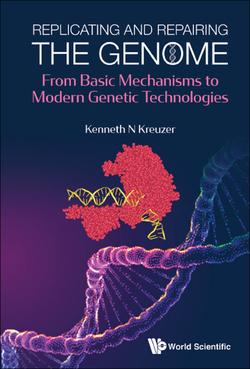Читать книгу Replicating And Repairing The Genome: From Basic Mechanisms To Modern Genetic Technologies - Kenneth N Kreuzer - Страница 35
На сайте Литреса книга снята с продажи.
3.6Housekeeping after the replisome passes — Repairing Okazaki fragments, reducing replicative errors, and recycling clamps from the DNA
ОглавлениеWhile the replisome is an efficient machine, several problems remain to be solved after it passes. The most obvious is that the lagging-strand DNA is not complete, but instead is left with multiple embedded RNA primers and discontinuities at the 5′ ends of these primers. As in the T7 system, the RNA primers need to be excised by a 5′ to 3′ exonuclease, replacement DNA bases need to be inserted, and the final nicks in the DNA need to be sealed. At the beginning of this chapter, we mentioned bacterial DNA polymerase I, which was actually the first DNA polymerase purified and characterized (resulting in the 1959 Nobel Prize for Arthur Kornberg). It turns out that this DNA polymerase plays a central role in Okazaki fragment processing. It was initially quite surprising to find that DNA polymerase I contained two exonuclease activities. As with DNA polymerase III, polymerase I has a 3′ to 5′ exonuclease that can edit out mistakes in which the polymerase activity inserted an incorrect base. It also has a 5′ to 3′ exonuclease, and this is the activity that normally removes the RNA primers from Okazaki fragments. Indeed, DNA polymerase I can carry out a concerted reaction called “nick translation,” in which it removes bases from in front of the enzyme with the 5′ to 3′ exonuclease and inserts new bases behind with the DNA polymerase activity (Figure 3.5; note that the position of the nick is “translating” along the DNA). Nick translation efficiently removes the short stretch of RNA at the 5′ ends of Okazaki fragments while replacing the RNA bases with DNA. If any bases are misincorporated during this replacement reaction, the incorrect base will very likely be removed by the proofreading 3′ to 5′ exonuclease activity of polymerase I before completion of the replacement reaction. The 5′ to 3′ exonuclease activity of DNA polymerase I is in a distinct domain of the protein, which can be released from the enzyme by proteolysis.3
1959 Nobel Prize in Physiology or Medicine
This prize was awarded jointly to Severo Ochoa and Arthur Kornberg for their studies on RNA (Ochoa) and DNA (Kornberg) synthesis; Kornberg isolated DNA polymerase from bacteria and demonstrated its ability to synthesize a complementary strand of DNA using a template strand. See legend to Figure 2.1 for details and attribution of DNA polymerase structure.
https://www.nobelprize.org/prizes/medicine/1962/summary/
Figure 3.5. Role of DNA polymerase I in final editing of Okazaki fragments. Escherichia coli DNA polymerase I has both 5′ to 3′ and 3′ to 5′ exonuclease activities, residing in different domains of the protein (panel A). The coordinated action of the 5′ to 3′ exonuclease and the (5′ to 3′) DNA polymerase is referred to as nick translation (panel B), since the location of the nick in the DNA is moving along the DNA. After the RNA residues are all removed, DNA ligase seals the nick to complete lagging-strand synthesis (not shown).
Once the RNA segments are replaced with DNA and the nick has migrated accordingly, the nick is sealed by bacterial DNA ligase. E. coli DNA ligase also plays critical roles in DNA repair reactions, as we will see later in the book.
The DNA synthesized by either DNA polymerase III or DNA polymerase I has very few remaining errors, thanks to the proofreading activities of these enzymes as described earlier. Nonetheless, without further corrective mechanisms, E. coli cells would suffer on the order of one mutation during every round of DNA replication. Measurements of mutation rates show that the frequency is about 100 times lower, demonstrating a very high level of genome stability. The increased fidelity of genome replication is achieved by means of a remarkable and efficient system of post-replication repair called mismatch repair, discussed in Chapter 6.
Another housekeeping issue following DNA replication involves the fate of the sliding clamps. As explained above, a new sliding clamp must be loaded by the replisome for each synthesized Okazaki fragment, which number in the thousands. However, a measurement of protein levels indicates that E. coli contains only a few hundred sliding clamps, so clamps must be recycled and reused. In the description of DNA replication above, the polymerase dissociated from the clamp as it cycled to the next RNA primer, but the clamp was left behind encircling the DNA and thus unable to dissociate. Surprisingly, it has been discovered that the clamp loader can also unload clamps, although it does not appear to do so immediately upon completion of Okazaki fragment synthesis. Instead, clamps are left behind on the just-synthesized lagging strand as the replisome races away.
This raises some interesting issues. Wouldn’t it be more efficient if the replisome itself unloaded clamps immediately for reuse? One compelling possibility is that the clamps serve a further function and are “intentionally” left behind for a period of time. Provocative evidence in support of this possibility is that both DNA polymerase I and DNA ligase can bind to the clamp. Thus, clamps left behind on each Okazaki fragment may help to direct the Okazaki fragment processing steps described earlier. Furthermore, one of the proteins involved in mismatch repair can bind to clamp, raising the possibility that the left-behind clamps also help direct mismatch repair. A good way to think about these results is that the replicative clamp serves as a “toolbelt,” capable of bringing multiple tools to bear for different tasks during the overall process of DNA replication. Further experiments are needed to decipher exactly how and when clamps are unloaded, and how extensively these three processes (Okazaki fragment processing, mismatch repair, and clamp unloading) are coordinated with each other.
